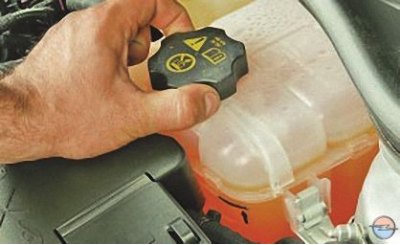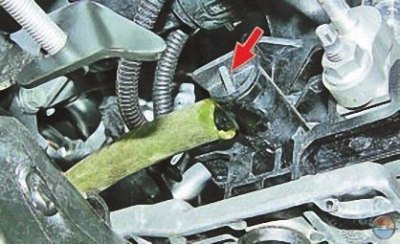You will need: flat-blade screwdriver, coolant, clean rag, capacity of at least 10 liters for draining coolant, pliers.
Attention! Use ethylene glycol based coolants (antifreeze).
Change the coolant only when the engine is cold.
The coolant is toxic, so be careful when handling it.
When starting the engine, the expansion tank cap must be closed. Screw the tank cap tightly. The cooling system is pressurized when the engine is running, so coolant may leak from under the loose cap.
1. Install the car on a flat horizontal platform.

2. Turn away a stopper of a broad tank.

3. Put a piece of hose of a suitable diameter on the drain valve on the radiator of the cooling system located in the lower part of the tank on the right side of the radiator, place a container under the hose and, turning off the valve..

4.... drain the liquid.
Warning! Antifreeze is deadly poisonous to all living things. In order not to pollute the environment, drain it from the radiator through a funnel (e.g. made from a plastic bottle). If you did not find a hose of a suitable diameter, you can use, for example, a cropped canister.

5. To ensure complete draining of the liquid from the system and guaranteed removal of air from it when refueling, squeeze the antennae of the clamp for fastening the throttle assembly heating hose, slide the clamp along the hose and remove the hose from the throttle assembly fitting.
6. Close the drain cock.
Note. If the expansion tank is heavily soiled, remove (see Removal and installation of a broad tank) and wash it.
7. Flush the cooling system by reinstalling the coolant supply hose to the throttle assembly and slowly fill the system with water through the expansion tank to the level of the steam outlet pipe.
8. Start the engine and let it run until the electric fan turns on.
9. Stop the engine and drain the water.
10. Flush the cooling system until clean water begins to drain.
11. Again disconnect a hose from the union of an intermediate tube of a supply of a cooling liquid to a throttle knot.

12. Fill the engine cooling system by pouring coolant into the expansion tank until it starts to pour out of the throttle assembly fitting and from the removed hose. At the moment the liquid starts to flow out, install the hose in place and secure with a clamp.
13. Start the engine and warm it up to operating temperature (before turning on the fan). After that, stop the engine, check the coolant level and, if necessary, add it to the expansion tank slightly above the mark «KALT/COLD».
Note. While the engine is running, observe the arrow on the coolant temperature gauge in the instrument cluster. If the arrow has moved to the red zone of the scale, and the radiator fan does not turn on, turn on the heater and check how much air passes through it. If the heater supplies heated air, the fan is most likely defective, and if it supplies cold air, then an air lock has formed in the engine cooling system. To remove it, turn off the engine, let it cool and unscrew the plug of the expansion tank. Start the engine, let it run for 3-5 minutes and tighten the reservoir cap.
Helpful Hints
For better filling of the system without air pockets, periodically squeeze the radiator hoses by hand.
After a few days of operation of the car after replacing the coolant, check its level. Top up if necessary.
If after a very short time the color of the fresh liquid turns brown, then you have poured a fake into which the manufacturer «forgot» add corrosion inhibitors. In addition, one of the signs of a fake is a sharp complete discoloration of the liquid. The dye of high-quality coolant is very resistant and only darkens over time. The liquid, tinted with linen blue, is discolored. Such «antifreeze» needs to be replaced quickly.

Visitor comments